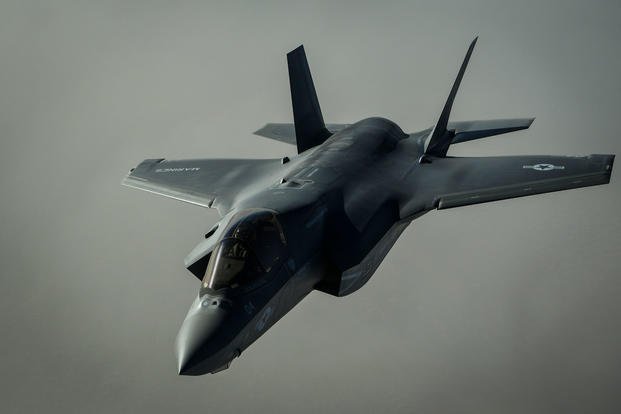Because of modifications to the F-35 Joint Strike Fighter fleet, spare parts that the U.S. Marine Corps took on its recent deployment overseas were not compatible with its fifth-generation fighters, according to a new watchdog report.
The lapse in supply chain management is one of myriad reasons the F-35 stealth jet fleet, operated across three services, is falling short of its performance and operational requirements, according to officials with the Government Accountability Office.
In a report published last week, the GAO found that spare parts shortages contributed to the F-35's overall lower-than-desired mission-capable rate.
"While DoD is taking various actions to improve F-35 spare parts availability so that aircraft can fly and perform their missions, it will likely continue to struggle to meet warfighter requirements -- due to how it is planning for and allocating spare parts," the GAO said.
Related content:
- Navy's F-35 Is Nowhere Near Combat-Ready, Watchdog Group Says
- Upgrades, Development to F-35 Jet Will Cost $1 Billion Per Year
- Glitchy Gun, Low Availability Rates Plague F-35, DoD Weapons Tester Finds
"F-35 aircraft were unable to fly nearly 30 percent [between] the May-November 2018 time period due to spare parts shortages," according to a summary finding in the report. Furthermore, the Pentagon "had a repair backlog of about 4,300 F-35 parts" in that timeframe, it said.
Only 27 percent of all F-35s were fully mission capable (FMC), or able to complete all of their missions in a wartime or training scenario. Roughly 50 percent of the fleet was considered mission capable (MC), or able to perform at least one of their core functions, the report said.
The GAO said the Pentagon's minimum target for full mission capability should hover around 60 percent, while its day-to-day mission-capable rate should be 75 percent.
The news comes as each service is rushing to meet former Defense Secretary Jim Mattis' requirement to raise mission-capable rates for four key tactical aircraft -- the F-16 Fighting Falcon, F/A-18 Hornet, F-22 Raptor and the F-35 -- to 80 percent by the end of fiscal 2019.
Following the report, Lockheed Martin Corp., the F-35 manufacturer, said it is "taking aggressive action" to work with the government and its supply base to improve readiness and reduce costs to maintain the jets.
"Lockheed Martin is taking aggressive action to build supply chain capacity, reduce supply chain costs and improve part availability to help drive sustainment costs down while enhancing readiness," the company said in a statement following the GAO's assessment.
"The F-35 global supply chain is a key enabler to success, and Lockheed Martin has and continues to conduct supply chain competitions, restructure supplier contracts, build supply chain capacity, synchronize spare buys, improve parts reliability and maintainability, implement advanced analytics tools, accelerate modifications to earlier aircraft, and support the stand-up of government-led regional warehouses and repair depots," the company said Thursday.
According to the GAO, the F-35A had the best fully mission-capable rate, at 34 percent, while the Marine Corps' short takeoff/vertical landing F-35B variant hit 16 percent. Only 2 percent of the Navy's F-35C carrier version hit FMC.
Lockheed said aircraft coming to the services from new production line batches "are averaging greater than 60 percent mission-capable rates, with some operational squadrons consistently at 70 percent."
The company cited progress with the Air Force, which "recently announced that its airmen and fleet of F-35As participating at Red Flag at Nellis Air Force Base delivered 90 percent MC rates during the exercise."
"Additionally, the U.S. Marine Corps achieved greater than 75 percent readiness rates with their F-35Bs during the first combat deployment," according to the company.
The GAO, however, has more concerns than capability rate shortfalls: The F-35 program doesn't have a streamlined plan to execute needed repairs or a speedy way to increase spare parts, according to the report.
"DoD's networks for moving F-35 parts around the world are immature, and overseas F-35 customers have experienced long wait times for parts needed to repair aircraft," the report states. "Without a detailed plan for the network, DoD may not be ready to support an expanding fleet."
That has been borne out in overseas operations.
In the Marine Corps, investigators found 382 out of 886 parts on the USS Wasp and 339 out of 768 parts on the USS Essex -- or roughly 45 percent of the 1,654 parts -- were incompatible with the fighters they had onboard. Those parts included pilot harnesses, masks, breathing hoses, fire extinguishers, sensor elements for the jet, batteries, electrical equipment, antennae, multiple types of valves and panel assemblies, the report states.
"The F-35 program does not have a process in place for changing out the parts within the afloat and deployment spares packages that are put on contract years before a deployment. Such a process is needed to ensure that the packages reflect the actual configurations of the deploying aircraft or updated demand projections for parts," the GAO said.
The latest challenges come as the Pentagon expects the F-35 to cost even more over the course of the program's lifetime.
A new estimate suggests that operating and supporting fighters for the next 60-plus years will cost the government $1.196 trillion, according to a Selected Acquisition Report provided to lawmakers earlier this month. The news was first reported by Bloomberg News.
The cost estimate, adjusted for inflation, grew by $73 billion just to sustain the jet, Bloomberg said.
The Defense Department plans to acquire 1,763 F-35A variants for the Air Force, 420 F-35Bs for the Marine Corps, and 273 F-35C carrier variants for the Navy.
-- Oriana Pawlyk can be reached at oriana.pawlyk@military.com. Follow her on Twitter at @Oriana0214.












